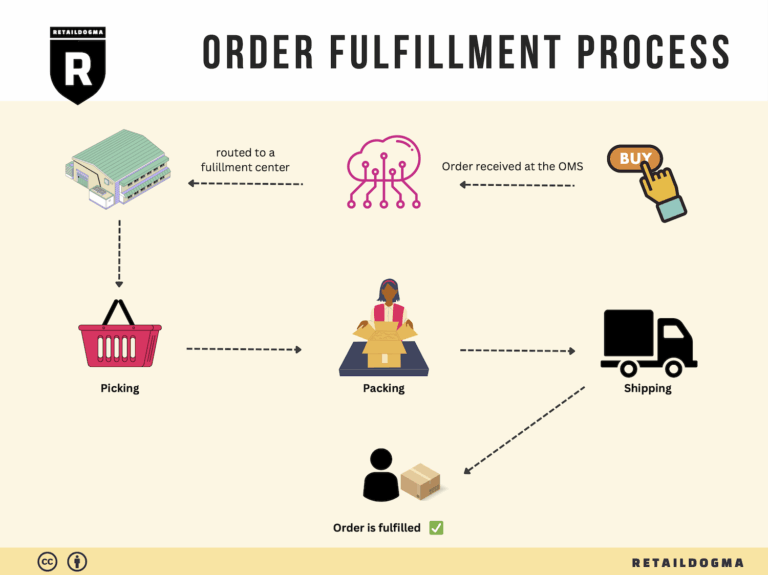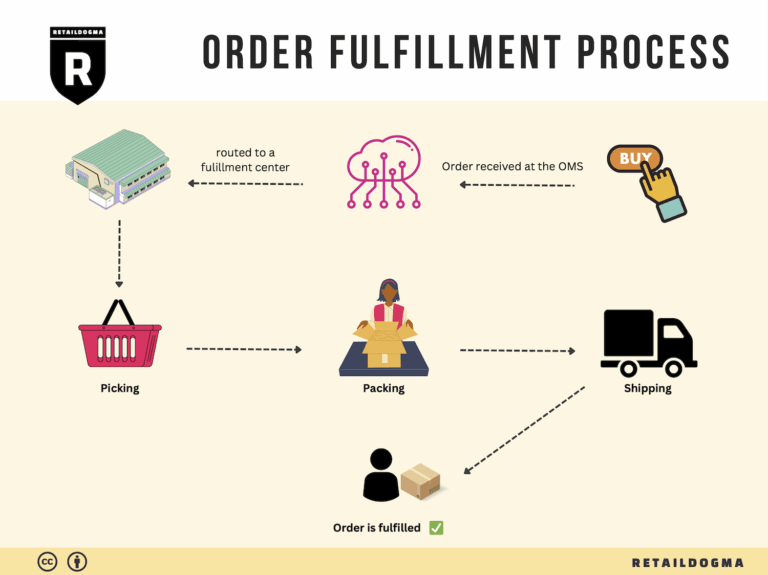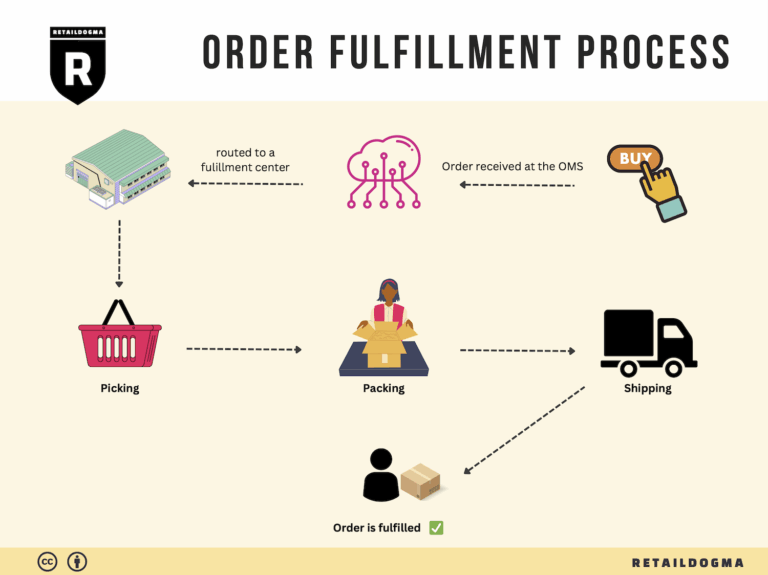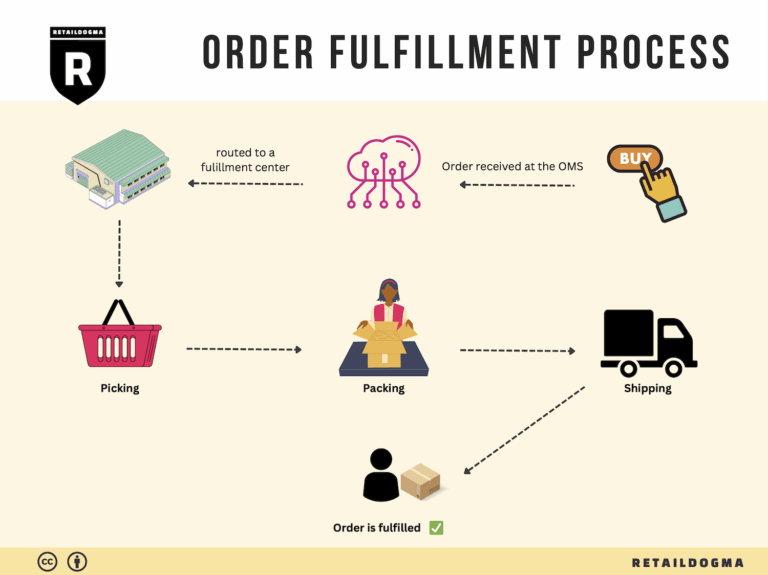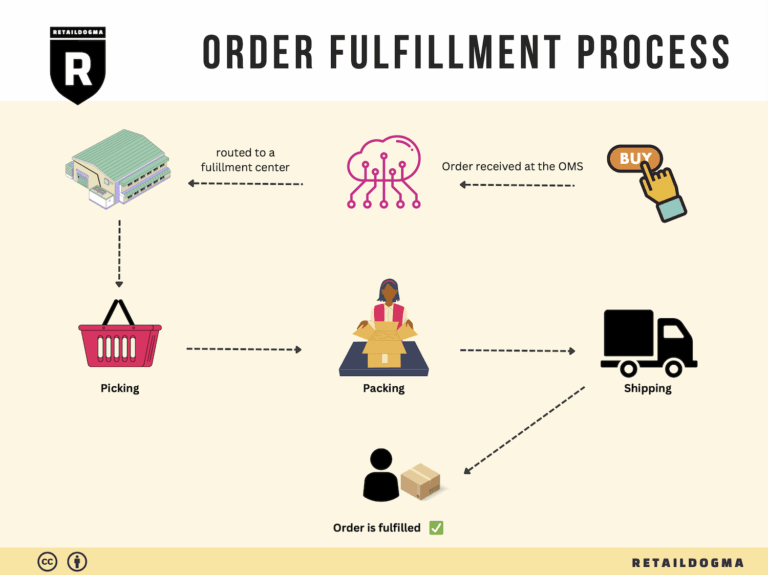What Is A Fulfillment Center? A Complete Guide (2025)
What is E-commerce Fulfillment? An Introduction for Growing Businesses
Understanding E-commerce Fulfillment: A Path to Streamlined Success
As an e-commerce business owner, you’re likely familiar with the overwhelming tasks that come with packing and shipping orders. The excitement of growing your sales can quickly turn into a logistical nightmare, as managing inventory, processing orders, and ensuring timely delivery can consume valuable time and resources. This is where understanding e-commerce fulfillment becomes crucial.
E-commerce fulfillment is simply the process of getting a product from your warehouse or store to your customer’s doorstep. It encompasses everything from receiving inventory and storing products to picking, packing, and shipping orders. As your business scales, the need for an efficient fulfillment strategy becomes even more apparent.
In this guide, we will delve into various fulfillment models that can help streamline your operations. You will learn about Third-Party Logistics (3PL) providers, which handle the entire fulfillment process for you, and Fulfillment by Amazon (FBA), which leverages Amazon’s vast distribution network to reach customers quickly. Understanding these models will enable you to choose the right approach based on your business needs.
Additionally, we will explore core services involved in the fulfillment process, including inventory management, order processing, and shipping. Each service plays a vital role in ensuring that your customers receive their orders accurately and on time, which is essential for maintaining a positive brand reputation.
Choosing the right fulfillment partner can be a daunting task. We’ll provide practical tips on what to look for in a logistics provider, including their technology capabilities, scalability, and customer service. A strong partnership can lead to more efficient operations, allowing you to focus on growing your business rather than getting bogged down in logistics.
Pricing is another critical aspect of fulfillment that we will cover. Understanding the costs associated with different fulfillment models and services will empower you to make informed decisions that align with your budget and profit margins.
Ultimately, this guide aims to empower you with the knowledge and tools necessary to make smart decisions about your logistics. By optimizing your e-commerce fulfillment strategy, you can not only enhance customer satisfaction but also drive sustainable growth for your business.
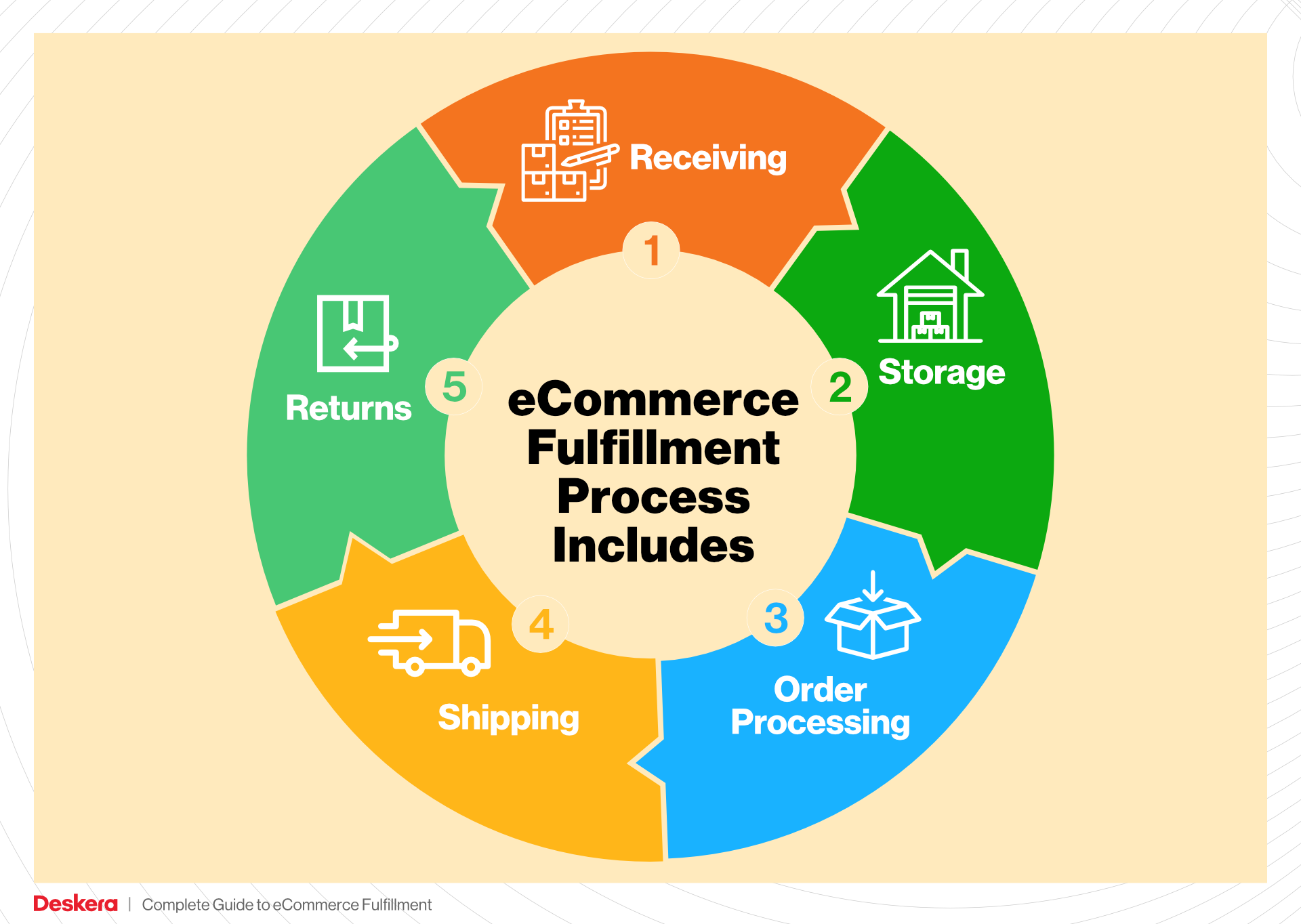
What You’ll Learn In This Guide
- What is E-commerce Fulfillment? An Introduction for Growing Businesses
- The Order Fulfillment Process: From ‘Buy’ Button to Customer’s Door
- Comparing Fulfillment Models: In-House vs. 3PL vs. Dropshipping
- A Deep Dive into Amazon FBA: Pros, Cons, and Who It’s For
- Core Services Offered by Fulfillment Centers
- How to Choose a Fulfillment Partner: A 6-Point Checklist
- Understanding Fulfillment Pricing: A Breakdown of Common Fees
- Frequently Asked Questions (FAQs) about Fulfillment
- Conclusion: Is Outsourcing Fulfillment the Right Move for Your Business?
- Important Disclaimer
The Order Fulfillment Process: From ‘Buy’ Button to Customer’s Door
1. Receiving Inventory
The first step in the order fulfillment process is receiving inventory. This involves the acceptance of goods from suppliers or manufacturers into your warehouse. Upon arrival, the inventory must be checked against the purchase order to ensure that the correct items and quantities have been delivered.
Importance: Accurate receiving is crucial because discrepancies can lead to stockouts, overstocking, and can severely impact customer satisfaction if the wrong items are sent out.
Key Term: SKU (Stock Keeping Unit) – Each product should have a unique SKU, which helps in tracking inventory accurately. Implementing a robust receiving process that includes scanning SKUs can streamline inventory management and reduce errors.
2. Warehouse Storage
Once inventory has been received and verified, it is stored in the warehouse. Efficient storage systems are essential to maximize space and ensure easy access to products. Items can be stored on shelves, pallets, or bins, depending on their size, weight, and demand frequency.
Importance: Proper warehouse storage optimizes space utilization and minimizes retrieval time during the picking process. It also helps maintain inventory organization, reducing the likelihood of misplaced items.
Key Term: ABC Analysis – This inventory categorization technique divides items into three categories (A, B, and C) based on their importance and turnover rates. High-demand items (A) are stored in easily accessible locations, while lower-demand items (B and C) can be placed further away.
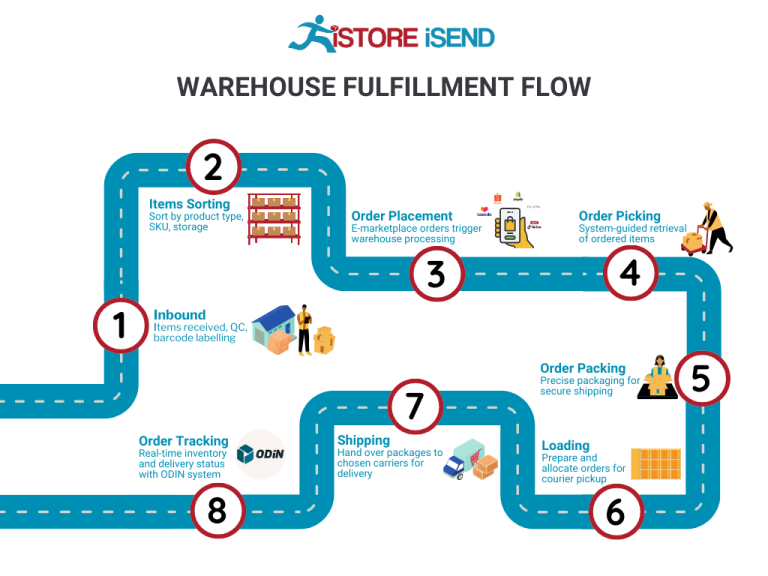
3. Order Picking
Order picking is the process of selecting and gathering items from the warehouse to fulfill customer orders. This step can be done manually or through automated systems. Efficient picking methods include single order picking, batch picking, and zone picking, depending on the order volume and warehouse layout.
Importance: Efficient picking directly affects order accuracy and fulfillment speed. The quicker and more accurately items are picked, the better the customer experience will be, leading to increased customer loyalty and repeat business.
Key Term: Pick Lists – These are documents or digital lists generated for the warehouse staff, detailing the items and quantities required for a specific order. Well-organized pick lists streamline the picking process and reduce errors.
4. Order Packing
After items are picked, they need to be packed for shipping. This step involves placing the selected items into appropriate packaging materials, ensuring that they are secure and protected during transit. Packing also includes labeling packages correctly and including any necessary documentation, such as invoices or return instructions.
Importance: Proper packing is vital to prevent damage during transit and to ensure compliance with shipping regulations. It also affects shipping costs; selecting the right size and type of packaging can save money on shipping fees.
Key Term: Packaging Materials – This term encompasses all the materials used to protect and present the product during shipping, including boxes, bubble wrap, and packing peanuts. Using sustainable packaging can also enhance your brand’s reputation.
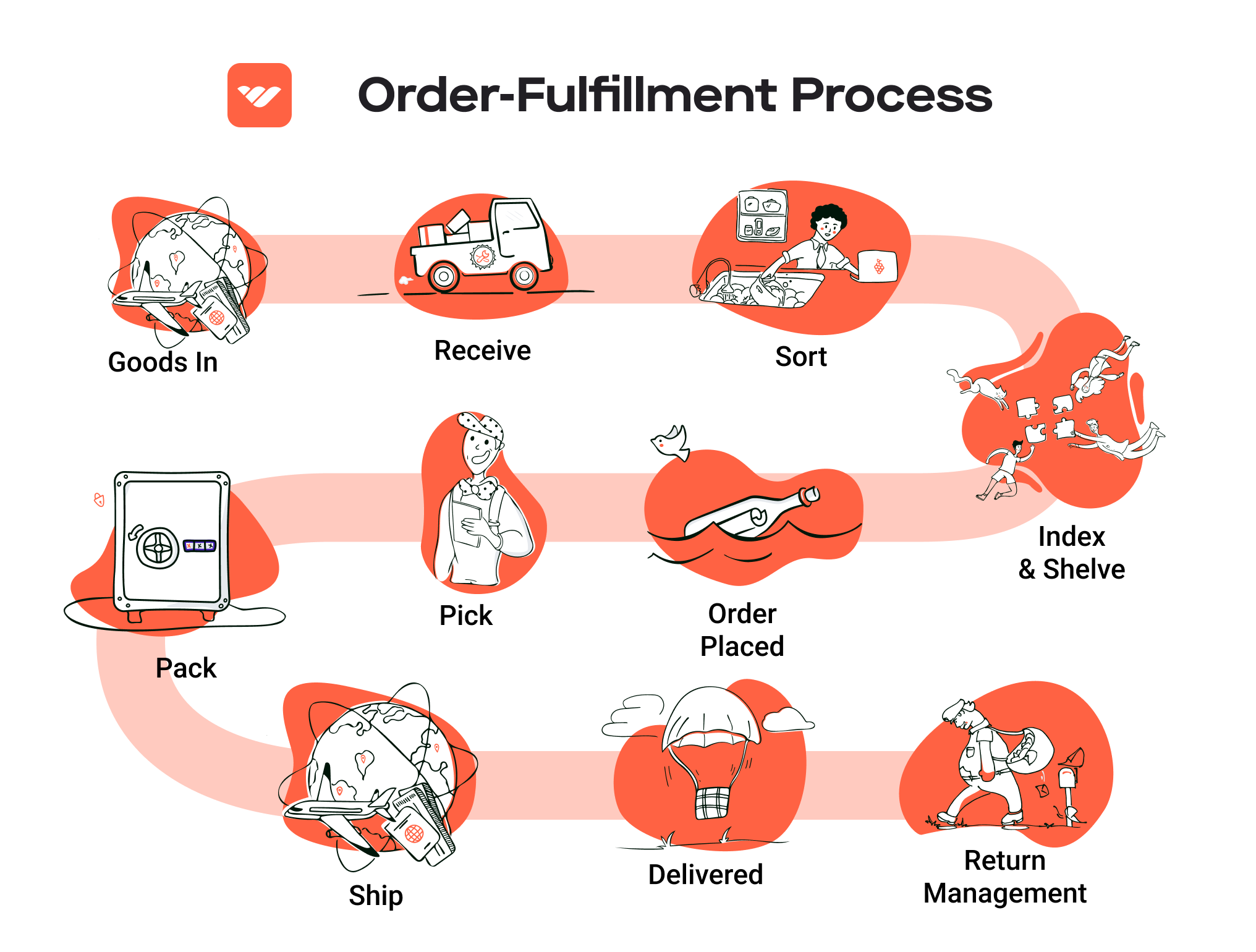
5. Shipping & Delivery
The final step in the order fulfillment process is shipping and delivery. Once orders are packed, they are handed over to shipping carriers for delivery to the customer. This step includes choosing the right shipping method based on cost, speed, and customer preference.
Importance: Timely and reliable shipping is critical to customer satisfaction. Providing tracking information can enhance the customer experience by allowing them to monitor their order’s status.
Key Term: Last-Mile Delivery – This term refers to the final step of the delivery process, where the product is transported from a distribution center to the end customer. Efficient last-mile delivery is essential for meeting customer expectations and can significantly impact overall fulfillment costs.
By understanding and optimizing each step of the order fulfillment process, e-commerce businesses can enhance operational efficiency, improve customer satisfaction, and ultimately drive growth.
Comparing Fulfillment Models: In-House vs. 3PL vs. Dropshipping
Fulfillment Model Comparison
| Model | Who Handles Inventory | Best For (Business Stage) | Key Advantage | Key Disadvantage |
|---|---|---|---|---|
| In-House Fulfillment | The Business Owner | Established Businesses | Complete control over inventory and fulfillment | High overhead costs and resource demands |
| Third-Party Logistics (3PL) | The 3PL Provider | Growing Businesses | Scalability and reduced operational burden | Less control over inventory management |
| Dropshipping | The Supplier | Startups and Small Businesses | Low upfront investment and risk | Lower profit margins and reliance on suppliers |
In-House Fulfillment
In-house fulfillment involves managing the entire inventory and logistics process within the business itself. This model is typically best suited for established businesses that have the capital and resources to invest in warehousing, staffing, and technology. One of the primary advantages of in-house fulfillment is the level of control it offers; businesses can oversee every aspect of their inventory management and shipping processes. This can lead to more personalized service and potentially faster shipping times, as the business can respond quickly to customer needs and changes in inventory levels. However, the key disadvantage is the high overhead costs associated with maintaining a warehouse, hiring staff, and managing operational logistics. This model requires significant investment and can be resource-intensive, which may not be feasible for smaller businesses or startups.
Third-Party Logistics (3PL)
Third-party logistics (3PL) providers handle the storage, fulfillment, and shipping of products on behalf of businesses. This model is particularly advantageous for growing businesses that need to scale their operations without the burden of managing logistics themselves. By outsourcing fulfillment to a 3PL, companies can focus on their core competencies, such as marketing and product development, while benefiting from the expertise and established systems of the logistics provider. The key advantage is scalability; as order volumes increase, the 3PL can easily adjust to meet demand without the business needing to invest in additional infrastructure. However, a notable disadvantage is the reduced control over inventory management. Businesses must trust their 3PL partner to manage stock levels, which can lead to issues if the provider does not meet expectations regarding accuracy and timeliness. Additionally, there can be hidden costs associated with using a 3PL, which can affect profit margins.
Dropshipping
Dropshipping is a fulfillment model where the retailer does not keep products in stock but instead transfers customer orders to a supplier who ships directly to the customer. This model is particularly suitable for startups and small businesses looking to minimize upfront investment and risk. The primary advantage of dropshipping is the low barrier to entry; entrepreneurs can start an e-commerce store with little to no inventory costs, allowing them to test products and markets without significant financial commitment. However, dropshipping also comes with its challenges. The key disadvantage is lower profit margins, as suppliers typically charge a premium for their services. Additionally, reliance on suppliers can lead to issues with inventory management and order fulfillment, which can affect customer satisfaction if not managed carefully. Retailers have limited control over shipping times and product quality, making it essential to choose suppliers wisely and establish clear communication channels.
A Deep Dive into Amazon FBA: Pros, Cons, and Who It’s For
Understanding Fulfillment by Amazon (FBA)
Fulfillment by Amazon (FBA) is a service offered by Amazon that enables sellers to store their products in Amazon’s fulfillment centers. Amazon takes care of storage, packaging, and shipping, as well as customer service and returns. This allows sellers to leverage Amazon’s vast logistics network and customer base, making it a popular choice for e-commerce businesses looking to scale.
How FBA Works
-
Setup: Sellers create an Amazon seller account and register for FBA. They prepare their products according to Amazon’s guidelines, including labeling and packaging.
-
Shipping to Amazon: Sellers ship their inventory to Amazon’s fulfillment centers. They can choose from multiple centers, allowing for strategic placement based on their target market.
-
Storage: Once received, Amazon stores the products in their warehouses. Sellers can monitor their inventory levels through the Amazon Seller Central dashboard.
-
Order Processing: When a customer places an order for a product, Amazon handles the picking, packing, and shipping. Products fulfilled by Amazon are eligible for Prime and other Amazon services, enhancing their visibility.
-
Customer Service: Amazon manages customer inquiries and returns, providing a seamless experience for both sellers and customers.
-
Payments: After the sale, Amazon deducts its fees and deposits the remaining balance into the seller’s account.
Pros of Fulfillment by Amazon
-
Prime Eligibility: Products fulfilled by Amazon are eligible for Amazon Prime. This increases sales potential, as Prime members tend to buy more due to the free two-day shipping.
-
Customer Trust: Amazon is a trusted platform, and using FBA can enhance a seller’s credibility. Customers are more likely to purchase from sellers who use FBA because of Amazon’s reliable shipping and customer service.
-
Multi-Channel Fulfillment: Sellers can use FBA to fulfill orders from other sales channels, such as their own website or eBay. This provides flexibility in managing inventory and shipping across multiple platforms.
-
Scalability: FBA allows businesses to scale without the need for extensive warehousing and logistics management. As demand grows, sellers can send more inventory to Amazon without needing to invest in additional storage facilities.
-
Time Savings: With Amazon handling logistics, sellers can focus on other aspects of their business, such as marketing and product development.
Cons of Fulfillment by Amazon
-
High Fees: FBA comes with various fees, including storage fees and fulfillment fees. These costs can add up, especially for low-margin products, impacting overall profitability.
-
Strict Inventory Rules: Amazon has stringent guidelines regarding inventory management. Sellers must ensure they comply with these rules to avoid penalties or removal from the platform.
-
Commingling Risks: FBA operates on a commingling model, meaning that products from different sellers can be stored together. This poses a risk if a customer receives a defective or counterfeit item, potentially leading to negative reviews for the seller.
-
Limited Control: Once products are in Amazon’s hands, sellers have limited control over the fulfillment process. Any issues related to shipping, packaging, or customer service are managed by Amazon.
-
Long-term Storage Fees: If inventory doesn’t sell within a certain timeframe, Amazon imposes long-term storage fees. This can force sellers to discount products or remove them from fulfillment centers, leading to losses.
Who is FBA Best For?
Fulfillment by Amazon is ideal for e-commerce businesses looking to scale quickly without the burden of managing logistics. It suits:
-
Small to Medium-Sized Businesses: Those who lack the resources to manage their own warehousing and shipping can benefit from FBA’s infrastructure.
-
Sellers with High Sales Volume: Businesses that anticipate high order volumes can leverage FBA to efficiently manage fulfillment.
-
Brands Seeking Prime Exposure: Sellers aiming to tap into Amazon’s Prime customer base will find FBA advantageous for increasing visibility and sales.
-
Multi-Channel Retailers: Companies selling across various platforms can streamline operations by using FBA for all order fulfillment, ensuring consistency and efficiency.
-
New Entrepreneurs: Startups can focus on marketing and product sourcing while Amazon handles logistics, making it easier to enter the market.
In conclusion, while Fulfillment by Amazon offers numerous advantages that can significantly enhance an e-commerce business’s reach and efficiency, it is essential to weigh these against the potential drawbacks. Understanding the operational intricacies and financial implications will help sellers make informed decisions about whether FBA is the right fit for their business model.
Core Services Offered by Fulfillment Centers
Inventory Management & Warehousing
Inventory management and warehousing are foundational services offered by fulfillment centers, serving as the backbone of efficient e-commerce operations. This service entails the systematic tracking and storage of products in a secure environment. Fulfillment centers utilize advanced inventory management systems that allow businesses to monitor stock levels in real-time, automate reordering processes, and forecast demand based on historical data and market trends.
The benefits of effective inventory management are manifold. For one, it reduces the risk of stockouts, ensuring that businesses can meet customer demands promptly, which is critical for maintaining high customer satisfaction and loyalty. Additionally, a well-organized warehouse optimizes space utilization, potentially lowering storage costs. This efficiency translates to faster order processing times, allowing businesses to provide quick shipping options that are increasingly expected by consumers. Moreover, real-time inventory tracking can help identify slow-moving products, enabling strategic decision-making regarding promotions or discontinuation.
Pick and Pack Services
Pick and pack services are essential for e-commerce businesses looking to streamline their order fulfillment process. This service involves selecting items from the warehouse shelves (picking) and packaging them for shipment (packing). Fulfillment centers employ trained staff and sophisticated technology to ensure that the right products are picked in the correct quantities and packed securely to prevent damage during transit.
The primary benefit of pick and pack services is the efficiency it brings to order fulfillment. By outsourcing this task to a fulfillment center, businesses can significantly reduce the time it takes to process and ship orders. This is particularly beneficial during peak seasons when order volumes surge. Additionally, fulfillment centers can often provide custom packaging solutions, allowing brands to enhance their unboxing experience, which is increasingly important in today’s competitive market. Enhanced customer experiences can lead to repeat purchases and positive word-of-mouth, bolstering brand reputation.
Kitting and Assembly
Kitting and assembly services involve combining multiple products or components into a single package or kit before shipping. This can include anything from assembling furniture pieces to creating gift baskets or promotional kits. Fulfillment centers that offer kitting services can help e-commerce businesses present products in a more appealing and convenient format for customers.
The benefits of kitting and assembly are particularly relevant for businesses looking to enhance their product offerings. By providing bundled products, businesses can increase perceived value and encourage larger purchases. Additionally, kitting can streamline operations by reducing the time customers spend searching for complementary products. For instance, a beauty brand could create a skincare kit that includes various products, simplifying the shopping experience. This service also enables businesses to respond quickly to market trends, allowing for seasonal or promotional kits that can drive sales spikes.
Returns Management (Reverse Logistics)
Returns management, or reverse logistics, is a crucial service that addresses the handling of returned products. Fulfillment centers manage the entire returns process, from receiving returned items to inspecting, restocking, or disposing of them as necessary. This service is particularly valuable in e-commerce, where return rates can be higher than in traditional retail.
The benefits of efficient returns management are significant for e-commerce businesses. First, a streamlined returns process enhances customer satisfaction by making it easy for customers to return products, which can increase their likelihood of future purchases. A hassle-free returns experience can differentiate a brand in a crowded marketplace. Furthermore, effective reverse logistics can minimize losses by quickly restocking salable items, thereby maintaining inventory levels and reducing the financial impact of returns. Businesses that leverage returns data can also gain insights into product quality and customer preferences, informing future product development and inventory decisions.
In summary, fulfillment centers offer a suite of core services that are essential for scaling e-commerce operations. By leveraging these services, businesses can enhance efficiency, improve customer satisfaction, and ultimately drive growth in a competitive landscape.
How to Choose a Fulfillment Partner: A 6-Point Checklist
Location & Warehouse Network
Importance: The geographical location of your fulfillment partner’s warehouses is crucial for ensuring timely deliveries and reducing shipping costs. A strategically located network can enhance service levels, especially if you are distributing printed materials or other time-sensitive items.
Questions to Ask:
1. Where are your warehouses located, and how does this align with my customer base?
2. Do you have multiple locations to ensure quicker delivery times?
3. How do you manage logistics in high-density areas, like the Northeast, where traffic and delivery challenges may arise?
4. What is your policy for managing unexpected delays in delivery?
Technology & Integrations
Importance: In today’s digital landscape, having robust technology is essential for efficient order processing, inventory management, and real-time tracking. A fulfillment partner with advanced technology can streamline operations and provide visibility into your supply chain.
Questions to Ask:
1. What technology platforms do you use for order management, inventory tracking, and reporting?
2. Can your system integrate with my existing e-commerce platform (e.g., Shopify, WooCommerce)?
3. How do you ensure data security and compliance with privacy regulations?
4. What kind of reporting and analytics capabilities do you offer to help me track performance?
Specializations (e.g., cold storage, oversized items)
Importance: Depending on your product offerings, it’s vital to partner with a fulfillment provider that specializes in handling specific types of goods. For instance, if you deal with cold storage products or oversized items, ensure the partner has the necessary infrastructure and expertise.
Questions to Ask:
1. What types of products do you specialize in, and do you have the facilities to handle my specific needs?
2. Do you have experience managing the logistics of fragile, perishable, or oversized items?
3. How do you maintain quality control for specialized items during storage and shipping?
4. Can you provide case studies or references for similar products you’ve fulfilled?
Scalability & Capacity
Importance: As your business grows, your fulfillment needs will evolve. Choosing a partner that can scale with you is vital for long-term success. They should be able to accommodate fluctuations in order volume, especially during peak seasons.
Questions to Ask:
1. How do you manage capacity during peak times (e.g., holidays, sales)?
2. Can you provide scalable solutions, such as additional warehouse space or staff during busy periods?
3. What is your policy for onboarding new clients or expanding services as my needs change?
4. How do you ensure that quality and speed of service are maintained even during high-volume periods?
Pricing and Contracts
Importance: Understanding the pricing structure and contract terms is essential to avoid unexpected costs and ensure that your fulfillment partner aligns with your budget. Transparent pricing models help in making informed financial decisions.
Questions to Ask:
1. What is your pricing structure, and what factors influence costs (e.g., storage fees, shipping rates)?
2. Are there any hidden fees that I should be aware of (e.g., for returns, extra handling)?
3. What are the terms of the contract, and how flexible are they if my needs change?
4. Can you provide a detailed breakdown of all potential costs associated with your services?
Customer Support & Reviews
Importance: Reliable customer support is vital for resolving issues quickly and maintaining a smooth operation. Additionally, checking reviews and testimonials can provide insights into the partner’s reliability and service quality.
Questions to Ask:
1. What customer support channels do you offer (e.g., phone, email, chat), and what are your hours of operation?
2. How quickly can I expect a response to inquiries or issues?
3. Can you provide references or testimonials from other clients in my industry?
4. What measures do you take to ensure customer satisfaction, and how do you handle complaints?
By following this comprehensive checklist, e-commerce business owners, operations managers, and entrepreneurs can make informed decisions when selecting a fulfillment partner. This strategic approach will not only enhance operational efficiency but also contribute to overall business growth and customer satisfaction.
Understanding Fulfillment Pricing: A Breakdown of Common Fees
Initial Setup Fees
Initial setup fees are typically charged when you first engage with a fulfillment center. These fees cover the costs associated with onboarding your products into their system, which may include inventory setup, system integration, and initial training sessions for your staff. The amount can vary significantly based on the complexity of your inventory and the fulfillment center’s requirements. For example, if your products require special handling or if you have a large catalog that needs to be uploaded into their system, you may incur higher fees.
Calculating initial setup fees often involves a flat rate or an hourly charge for the time spent on these activities. It’s essential to discuss what specific services are included in this fee to avoid unexpected costs.
Receiving Fees
Receiving fees are incurred when your products arrive at the fulfillment center. These fees cover the labor and resources needed to unload, inspect, and catalog your products. They can vary based on the volume and nature of your shipments. For instance, receiving a large shipment of magazines may take more time and resources than a smaller shipment of specialized items.
Typically, receiving fees are calculated based on a per-pallet or per-box rate, which can range from $10 to $30 per pallet depending on the fulfillment center. Understanding the volume of your shipments and negotiating these fees in advance can significantly impact your overall fulfillment costs.
Storage Fees (per pallet/bin)
Storage fees are charged for keeping your inventory at the fulfillment center. These fees are crucial for businesses with fluctuating inventory levels, as they can accumulate quickly. Storage fees are usually calculated on a monthly basis, either per pallet or per bin, and can range from $15 to $50 per month per pallet.
The calculation often depends on the amount of space your products occupy, with larger or heavier items attracting higher fees. To manage these costs effectively, it’s advisable to maintain an optimal inventory level and regularly assess your storage needs. Consider negotiating a tiered storage rate, which can offer savings if you have consistent stock levels.
Pick & Pack Fees (per item/order)
Pick and pack fees are charged for the labor involved in selecting items from your inventory and packaging them for shipment. This fee is crucial for understanding the overall cost of order fulfillment. These fees can vary based on the complexity of the order, the number of items being packed, and the packaging materials used.
Generally, pick and pack fees are calculated per item or per order, with costs ranging from $1 to $5 per item. For example, an order containing multiple products may incur higher pick and pack fees than a single-item order. To optimize these costs, consider streamlining your product offerings and using standardized packaging materials, which can reduce both time and expense.
Shipping Fees
Shipping fees are among the most variable costs in fulfillment pricing and depend on several factors, including the weight and dimensions of the package, the shipping method selected, and the destination. Most fulfillment centers negotiate rates with carriers and pass those savings onto you, but it’s essential to understand how these fees are structured.
Shipping fees can be calculated per shipment or based on weight brackets, with costs ranging widely based on the carrier. For example, standard ground shipping may be more economical than expedited shipping. To minimize shipping fees, consider consolidating orders, optimizing packaging sizes, and selecting the most cost-effective shipping methods available.
Tips for Getting an Accurate Quote
-
Be Specific: Provide detailed information about your products, including dimensions, weights, and handling requirements. The more accurate the information, the more precise the quote.
-
Understand Your Needs: Clearly define your fulfillment needs, including order volumes, peak seasons, and product types. This helps fulfillment centers tailor their quotes to your business.
-
Ask About All Fees: Inquire about every potential fee, including hidden costs like return handling, additional storage, or special packaging. Understanding the complete pricing structure will help you avoid surprises.
-
Compare Quotes: Don’t settle for the first quote you receive. Compare multiple fulfillment centers to understand the market rates and services offered.
-
Negotiate: Many fulfillment centers are open to negotiation, especially if you can guarantee a certain volume of business. Leverage your position to seek better rates or additional services.
By understanding these common fulfillment pricing models and following these tips, you can make informed decisions that support the growth and efficiency of your e-commerce operations.
Frequently Asked Questions (FAQs) about Fulfillment
1. What is publishers circulation fulfillment?
Publishers circulation fulfillment refers to the processes involved in the distribution and delivery of printed media, such as newspapers, magazines, and catalogs, to subscribers and retailers. It encompasses everything from order processing and inventory management to logistics and last-mile delivery, ensuring that publications reach their intended audience on time.
2. How does publishers circulation fulfillment differ from standard e-commerce fulfillment?
While both types of fulfillment involve managing inventory and shipping products to customers, publishers circulation fulfillment is specifically tailored for printed media. It often requires unique considerations such as subscription management, timely delivery schedules (often early morning), and handling bulk shipments to newsstands or retailers. Additionally, it typically involves a more complex delivery network due to the high density of urban areas.
3. What are the key components of a successful fulfillment strategy?
A successful fulfillment strategy should include:
– Inventory Management: Efficient tracking and management of stock levels.
– Order Processing: Quick and accurate processing of incoming orders.
– Logistics and Transportation: Reliable methods for delivering products, including last-mile delivery solutions.
– Customer Communication: Keeping customers informed about their orders and any potential delays.
– Technology Integration: Utilizing software for tracking, reporting, and optimizing fulfillment operations.
4. What is a 3PL (Third-Party Logistics) provider?
A 3PL provider is an outsourced service that manages a company’s logistics and supply chain operations. This can include warehousing, inventory management, transportation, and fulfillment services. For publishers, partnering with a 3PL can streamline the distribution process, reduce operational costs, and enhance service levels without the need for significant capital investment in logistics infrastructure.
5. How much do fulfillment services typically cost?
Fulfillment service costs can vary widely based on factors such as volume, complexity of operations, and specific service requirements. Generally, costs may include:
– Storage Fees: Based on the amount of inventory held.
– Pick and Pack Fees: Charged per order processed.
– Shipping Costs: Vary by carrier and destination.
– Additional Services: Such as returns management or special packaging, which may incur extra charges. It is advisable to obtain quotes from multiple fulfillment providers to compare pricing structures.
6. What technology is essential for effective fulfillment?
Key technologies that enhance fulfillment operations include:
– Warehouse Management Systems (WMS): For tracking inventory and managing warehouse operations.
– Order Management Systems (OMS): To handle order processing and customer communications.
– Transportation Management Systems (TMS): For optimizing shipping routes and managing carrier relationships.
– Reporting and Analytics Tools: To monitor performance metrics and identify areas for improvement.
7. How can I scale my fulfillment operations as my business grows?
To scale fulfillment operations effectively:
– Invest in Technology: Implement advanced software solutions that automate processes.
– Optimize Inventory Management: Use data analytics to forecast demand and adjust stock levels accordingly.
– Expand Partnerships: Collaborate with additional carriers or 3PL providers to enhance delivery capabilities.
– Streamline Processes: Continuously review and refine workflows for efficiency and speed.
8. What are the common challenges in publishers circulation fulfillment?
Common challenges include:
– Delivery Timeliness: Ensuring that publications reach customers before specific deadlines, particularly for daily newspapers.
– Inventory Management: Balancing stock levels to meet fluctuating demand without incurring excess costs.
– Returns Handling: Managing unsold or returned publications efficiently.
– Market Competition: Staying competitive in an increasingly digital landscape while maintaining profitability.
9. How do I choose the right fulfillment partner?
When selecting a fulfillment partner, consider:
– Experience and Specialization: Look for providers with a proven track record in publishers circulation fulfillment.
– Technology Capabilities: Ensure they use modern technology for inventory and order management.
– Service Flexibility: Choose partners that can adapt to your specific needs and scale with your business.
– Reputation and Reviews: Research customer feedback and case studies to gauge their reliability and service quality.
10. What is the difference between a warehouse and a fulfillment center?
A warehouse is primarily focused on storing products and may not have the infrastructure for order processing or shipping. In contrast, a fulfillment center is equipped to handle the entire order fulfillment process, including picking, packing, and shipping items directly to customers. Fulfillment centers are designed for efficiency in processing large volumes of orders quickly, which is essential for businesses with high turnover rates.
Conclusion: Is Outsourcing Fulfillment the Right Move for Your Business?
The Advantages of Outsourcing Fulfillment
Outsourcing your fulfillment operations can be a transformative decision for your business. The most significant benefits include saving valuable time, enhancing scalability, and leveraging specialized expertise. By partnering with a fulfillment service, you can redirect your focus from logistics to core business activities, such as marketing and product development. This shift not only streamlines your operations but also allows you to respond more effectively to market demands.
Scalability is another compelling reason to consider outsourcing. As your business grows, so do the complexities of managing inventory, processing orders, and ensuring timely deliveries. A reliable fulfillment partner can seamlessly scale with your business, accommodating seasonal spikes in demand or expanding into new markets without the burden of additional overhead. Their established logistics networks and technological infrastructure can provide you with the flexibility necessary to adapt to changing business landscapes.
Moreover, working with a fulfillment service grants you access to industry expertise that you may not possess in-house. These partners often have decades of experience and sophisticated systems designed to optimize the fulfillment process, reduce shipping costs, and improve customer satisfaction. This expertise can be invaluable as you look to elevate your brand’s presence and performance in a competitive marketplace.
Choosing the Right Partner for Growth
It’s crucial to select a fulfillment partner that aligns with your business goals and values. Take the time to research potential partners, assess their service offerings, and ensure their operational capabilities meet your specific needs. The right fulfillment partner can be a catalyst for growth, enabling you to scale your operations effectively while maintaining a focus on your core competencies.
Call to Action
To determine if outsourcing fulfillment is the right next step for your business, conduct a thorough audit of your current shipping and logistics processes. Identify pain points and inefficiencies, and consider how a fulfillment service could enhance your operational capabilities. Embrace this opportunity for growth and innovation; the right partnership could propel your business to new heights.
Important Disclaimer
⚠️ Important Disclaimer
The information in this guide is for educational purposes. Fulfillment services, pricing, and platform features change frequently. Always conduct your own due diligence and consult with providers directly before making business decisions.

